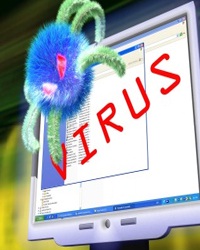If you believe that your computer is infected by viruses it is possible to attempt to remove them by yourself. Before consulting a professional, try following these steps to remove a computer virus.
What is the difference between getting hacked and getting virus? – Explained for you.
Step 1 – Disconnect Computer:
First, make sure to disconnect your computer from the internet, local area networks and external storage drives. The best way to do this is to completely remove all wires, except the power, display and mouse/keyboard, from the computer. This will ensure that the virus will not be able to infect any other computers or duplicate itself elsewhere.
Step 2 – Install Anti-virus Software:
If you do not already have anti-virus software installed on your computer make sure to install it now. As you have already disconnected your computer you should install a copy from disc or a USB stick rather than risk using the internet to download it. You refer to this post Secure Your PC For Life Time With Avast Antivirus For Free! to get some real time antivirus software to protect your computer.
Step 3 – Clear Cache:
Once the anti-virus software is installed, open all your internet browsers and clear the cache, cookies and web history.
Step 4 – Restart in Safe Mode:
After clearing the internet cache, restart your computer in safe mode. This will start your computer with only the absolute minimum system services required for the computer to run, which should lower the chances of interference from viruses.
If you want to build a website like mine, you can buy the hosting from Hostgator. I always recommend this web service. You can also read the article Why I am Using Hostgator as Hosting Company for the Last 4 Years to get an idea about why I use HostGator for as my hosting provider.
Step 5 – Scan for Viruses:
Once you have booted into safe mode run the anti-virus software. This process might take a long time, but make sure not to interrupt it whilst it is scanning the system. Once the scan has been completed select the option to remove any viruses the software has found.
Step 6 – Check for Spyware:
Not all anti-virus software packages contain the tools to check for spyware. If you are unsure whether your software can detect spyware, it is worth installing anti-spyware software and checking for this separately.
Step 7 – Restart the Computer and Re-scan:
Now that the viruses have been removed in safe mode, restart the computer and perform another scan. This should confirm that your system is free from infection, but if problems persist you may need professional help.
Step 8 – Download Updates:
If the check comes up clean, reconnect to the internet and download updates to both your operating system and anti-virus software. If updates are available for your anti-virus software re-scan your system after installing them. Know How To Download Movie From Extratorrent?
Step 9 – Monitor Your System:
Over the next few days, pay close attention to your computer and see if there is any suspicious activity. If you believe that your system still has problems you should seek out a professional.
Step 10 – When to Seek Professional Help:
There are a number of instances when you should seek the help of a professional. For example, some computer viruses are able to masquerade as important admin files (Rootkit viruses), mutate themselves to avoid detection (Polymorphic viruses) or lock users out of their system completely. When one of these instances occurs, anti-virus software may not be able to provide a solution, and any chance of recovering your data will be beyond your means.



